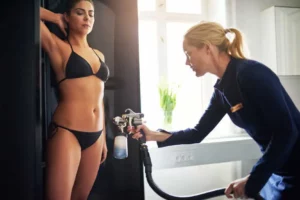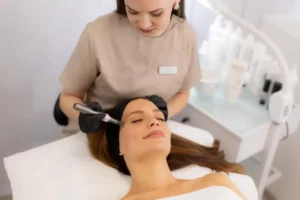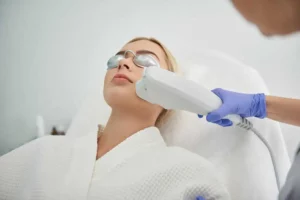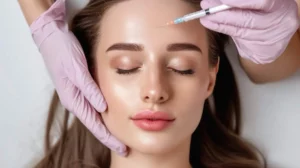Introduction
Exploring the skincare treatments, medical grade chemical peels stand out as a transformative option for those seeking to rejuvenate and enhance their skin’s appearance. This procedure, involving the application of a chemical solution to exfoliate damaged skin layers, promises a range of benefits, from improved texture to reduced signs of aging. Let’s uncover the insights of a medical grade chemical peel, discussing its types, application techniques, safety tips, and the anticipated results for informed skincare decision-making.
What are Medical Grade Chemical Peels?
Chemical peels of medical grade are skin-resurfacing treatments that include applying a chemical solution to the skin and removing its outermost layers. After a peel, the skin regenerates with smoother, younger-looking skin. Usually on the face, these peels are used to address scars, discoloration, and wrinkles.
Types of Medical Grade Chemical Peels
Medical grade chemical peels are categorized based on their depth of skin penetration, which also determines their strength and the type of skin concerns they address. The three main types are:
Superficial Peels (Light Peels)
- Active Ingredients: Usually contain alpha-hydroxy acids (AHAs) like glycolic acid, lactic acid, or mild beta-hydroxy acids (BHAs) like salicylic acid.
- Penetration Level: Affect only the outermost layer of the skin, the epidermis.
- Purpose: Designed to gently exfoliate and improve the appearance of mild skin irregularities like minor discoloration, rough texture, and dryness.
- Downtime: Minimal to none, making them ideal for those who want a peel with minimal recovery time.
- Frequency: Can be done more frequently than deeper peels, often every 4-6 weeks.
Medium Peels
- Active Ingredients: Commonly use trichloroacetic acid (TCA) in a higher concentration than in superficial peels, sometimes combined with AHAs.
- Penetration Level: Reach the outer and middle layers of skin (the epidermis and the upper part of the dermis).
- Purpose: Target more pronounced skin issues such as moderate lines and wrinkles, pigmentation problems, and acne scars.
- Downtime: Takes some time off, often a week or more, as the skin needs time to repair and rejuvenate. The skin may be red, swollen, and peel for several days.
- Frequency: Typically performed once every 3 to 6 months, depending on individual skin concerns and healing process.
Deep Peels
- Active Ingredients: Often contain phenol or high concentrations of TCA.
- Penetration Level: Affect the deeper layers of the dermis.
- Purpose: Address more serious skin concerns such as deeper wrinkles, precancerous growths, extensive sun damage, and significant acne scars.
- Downtime: Extensive, requiring several weeks for the skin to heal. This type of peel often involves significant peeling, crusting, swelling, and requires longer recovery time.
- Frequency: Usually a one-time procedure due to its intensity and the profound changes it makes in the skin.
Each type of peel has its own set of indications, benefits, and potential side effects. To choose the best kind of chemical peel for your skin type and issues, it is essential that you speak with a dermatologist or other certified skincare specialist. They can also provide guidance on pre-treatment care, post-peel care, and what results to expect.
The Procedure
The medical grade chemical peel procedure involves several steps to ensure treatment effectiveness and patient safety, varying depending on the type of peel. The basic steps typically include:
Consultation and Evaluation:
- Initial Consultation: The dermatologist assesses skin type and reviews medical history.
- Skin Evaluation: Determines suitable peel type and identifies potential issues.
- Pre-Treatment Instructions: Guidelines on skincare preparation and sun avoidance.
Day of the Peel:
- Cleansing: Removal of oils, dirt, and makeup from the skin.
- Protecting Sensitive Areas: Eyes, lips, nostrils protected with ointment or tape.
- Application of Chemical Solution:
- Superficial Peels: Mild acids like glycolic or salicylic acid are applied.
- Medium Peels: Stronger acids such as trichloroacetic acid used; blue peel variant may be applied.
- Deep Peels: Phenol or high concentration of trichloroacetic acid; may require sedation.
- Monitoring: Solution left on skin for a specific time based on peel strength.
- Neutralizing the Peel: Neutralizing solution or wash applied for certain peels.
- Applying Post-Peel Care: Soothing creams or gels, cool compresses used.
After the Procedure:
- Recovery Time: Varies from minimal (superficial) to several weeks (deep peels).
- Skin Care Post-Peel: Gentle cleansing, moisturizing, strict sun avoidance.
- Peeling: Treated skin peels off over a period of days or longer.
- Follow-up: Appointment to monitor healing and address concerns.
Professional Guidance Essential:
Expert supervision is vital in administering medical grade chemical peels; these procedures should be exclusively adminitered by trained professionals to guarantee both safety and efficacy. Adhering to your skincare specialist’s specific pre- and post-care instructions is essential for achieving the best results and minimizing potential risks. This professional oversight guarantees a safer, more effective treatment experience, tailored to your individual skin needs.
Safety and Considerations
Suitability and Medical History
- Skin Evaluation: To determine if a chemical peel is suitable for your skin type and issues, a skincare expert needs to complete an assessment.
- Medical History Review: Discuss any history of scarring, cold sores, or facial X-rays with your dermatologist.
Informed Consent
- Understanding the Procedure: Be aware of the procedure details, including potential risks and benefits.
- Realistic Expectations: Clearly understand what chemical peels can and cannot achieve.
Pre-Treatment Care
- Skin Conditioning: Use pre-treatment products as advised by the dermatologist to prepare the skin.
- Medication Adjustments: Inform the specialist about any current medications; some may need to be adjusted or avoided.
During the Procedure
- Professional Administration: Ensure a qualified professional performs the procedure in a controlled, sterile environment.
- Pain Management: For deeper peels, pain relief or sedation might be necessary.
Post-Treatment Care
- Skin Protection: Follow a strict skincare regimen post-peel, including sun protection.
- Avoiding Certain Activities: Avoid strenuous activities and direct sun exposure immediately after the peel.
Potential Risks and Side Effects
- Mild Reactions: Redness, dryness, stinging, or slight swelling are common.
- Severe Complications: Although rare, include infection, scarring, or unwanted pigment changes.
- Special Attention for Deep Peels: These require more rigorous post-treatment care and carry a higher risk of complications.
Follow-Up
- Regular Check-Ups: Essential for monitoring the skin’s skin’sg process.
- Adjusting Skincare Routine: Based on the skin’s skin’sse to the peel.
Special Considerations
- Skin Color: Individuals with darker skin tones are more susceptible to pigment alterations in their skin.
- Cold Sores: Those prone to cold sores may experience outbreaks post-peel.
- Avoiding DIY Peels: Over-the-counter peels may not be safe for all skin types and could lead to complications.
Safety in medical grade chemical peels hinges on professional assessment, clear communication, and adherence to pre- and post-treatment instructions. Understanding the risks and benefits, while following the guidance of a qualified dermatologist, ensures a safer and more effective outcome.
Conclusion
Medical grade chemical peels can offer transformative results for your skin, addressing a range of concerns from fine lines to scarring. At ReViVe Aesthetics & Healthcare in Rockwall, TX, we specialize in providing top-quality, individualized medical grade chemical peels to exfoliate and remove the top layer of skin, reducing concerns like wrinkles, fine lines, acne scars, and uneven skin tone. Unlock the secret to radiant, youthful skin with a medical grade chemical peel, a game-changer in the world of advanced skincare solutions.







